Corydalinae
Dobsonflies, hellgrammites
Atilano Contreras-Ramos


This tree diagram shows the relationships between several groups of organisms.
The root of the current tree connects the organisms featured in this tree to their containing group and the rest of the Tree of Life. The basal branching point in the tree represents the ancestor of the other groups in the tree. This ancestor diversified over time into several descendent subgroups, which are represented as internal nodes and terminal taxa to the right.

You can click on the root to travel down the Tree of Life all the way to the root of all Life, and you can click on the names of descendent subgroups to travel up the Tree of Life all the way to individual species.
For more information on ToL tree formatting, please see Interpreting the Tree or Classification. To learn more about phylogenetic trees, please visit our Phylogenetic Biology pages.
close boxIntroduction
The subfamily Corydalinae (dobsonflies) of Corydalidae includes some of the largest and most impressive of extant insects, such as males of Central American Platyneuromus with bizarre looking postocular flanges (cf. Glorioso and Flint 1984), and those of Asian Acanthacorydalis and American Corydalus both bearing disproportionately long mandibles (cf. Glorioso 1981).

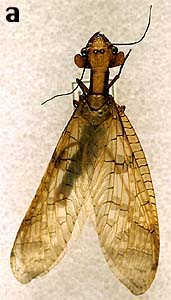
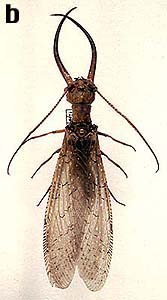
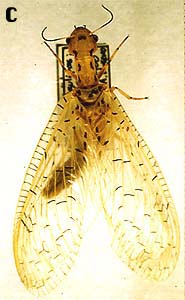
Representatives of the three different genera of the Corydalus lineage of dobson flies. a. Male Platyneuromus soror (Hagen) with postocular flanges, Costa Rica. b. Male Corydalus luteus Hagen with long mandibles, Nuevo León, Mexico. c. Female Chloronia mexicana Stitz, Tamaulipas, Mexico. Photographs copyright © 1997, Atilano Contreras-Ramos
At least in Corydalus, there is evidence that males would fight over females using their long mandibles, and so the latter might be associated with sexual selection and perhaps could be used as a means of defense. However, the postocular flanges in Platyneuromus, analogously more developed in males of large size (as the elongate mandibles in Corydalus) are not known to have a particular function.
The aquatic larvae (hellgrammites) are a conspicuous component of the benthic macroinvertebrate fauna of streams and rivers. Due to their large size, rather ferocious nature, as well as to their endurance as bait, they are well known to fishermen and aquatic biologists.

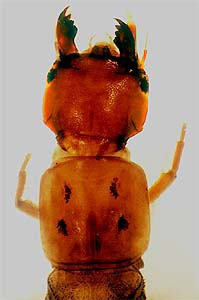
Dobson fly larva, Chloronia mexicana Stitz, Tamaulipas, Mexico. Photograph copyright © 1997, Atilano Contreras-Ramos
Glorioso's (op. cit.) perception of a world dobsonfly fauna of less than 50 species has definitely fallen short. New and Theischinger (1993) estimate that there are about 100 nominal species of Corydalinae. On the same token, there are 47 currently recognized species only in the New World (Glorioso and Flint 1984; Contreras-Ramos 1995, 1998, 1999). Nine genera are currently recognized for the subfamily. Those of the New World are in good taxonomic condition, however considerable revisionary work remains to be done in the Old World genera (e.g., Protohermes).
Characteristics
Adults of Corydalinae measure 45-180 mm of wingspan and can be distinguished by having a subquadrate head with postocular ridge, spine, and plane, as well as a microsetose gular region and well developed ninth gonostyli (Glorioso 1981). Adult coloration is quite variable, however wings of most species are rather dark and dull colored, often grayish, brownish, to nearly black. Wings of some species are nicely patterned, few are nearly hyaline to pale yellow. Head sculpturing may also be characteristic, some species having uniform and rather smooth heads to others having neatly patterned (e.g., reddish and yellow) textures.
Dobsonfly larvae can be separated by the lateral abdominal filaments on segments 1-8, the last abdominal segment with a pair of filaments and divided into two prolegs (each with a pair of claws), and especially by the ventral gill tufts on abdominal segments 1-7 (cf., Neunzig and Baker 1991, Evans and Neunzig 1996).
Discussion of Phylogenetic Relationships
Monophyly of the Corydalinae
Glorioso (1981) proposed three characters as synapomorphies for Corydalinae (his characters 1, 2, and 3), these are a microsetose gular setation, and presence of a postocular ridge and a postocular plane. Some other characters may also be apomorphic for Corydalinae (Contreras-Ramos 1998), for instance presence of a postocular spine, male cerci free from 10th tergites, distinct male 9th gonostyli, and distinct female gonostyli. However, it is important to consider that the above proposed synapomorphies have resulted from analyses at the genus level (i.e., within Corydalinae), and so some may not hold as such at a higher level of analysis (i.e., between Sialidae, Chauliodinae, and Corydalinae).
General Relationships
Glorioso's (1981) excellent genus level revision of the subfamily also included an analysis of genera relationships. Penny (1993) revised Gloriso's analysis and incorporated the South African Chloroniella, which was missing from Glorioso's study due to scarcity of museum specimens. Both phylogenies have the same topology, except for the inclusion of Chloroniella in Penny's (who also made a few modifications to Glorioso's original set of characters):
============= Neurhermes
==Protohermes assemblage=|
| ============= Protohermes
|
| =================================== Chloroniella
| |
| | ========== Neoneuromus
| | ==Neuromus assemblage=|
=====| | | ========== Neuromus
| | |
===| | ========= Acanthacorydalis
===| |
| | ====== Platyneuromus
==Corydalus assemblage=| |
===| === Chloronia
===|
=== Corydalus As a test of the monophyly of Corydalus, Contreras-Ramos (1998) included examples of all genera with typical and atypical Corydalus species. This analysis is an independent assesment of relationships with respect to earlier works. The resulting tree (see above) shares most features with previous ones, however differs in the position of Chloroniella and Acanthacorydalis. Here Chloroniella is placed as sister to all other dobsonfly genera (the most basal position), and Acanthacorydalis is moved from sister taxon to the American genera (Platyneuromus, Chloronia, and Corydalus) to basal member of the Neuromus lineage (Neuromus and Neoneuromus). The sister group relationships between Neurhermes and Protohermes, and Neuromus and Neoneuromus, respectively, seem well supported. For instance, three branches of vein 1A, a short and broad male 9th tergum, and a deeply concave posterior margin of the male 9th tergum support the former pair, and the presence of cubital accessory crossveins and a very long female spermathecal duct groups the latter two taxa.
Phylogenetic Position of Chloroniella and Acanthacorydalis
A most basal position of Chloroniella is supported by the characters robust head, reduced mandibular dentition, anteclypeus fused to postclypeus, and linear posterior tentorial pits (among others). On the other hand, the position of Acanthacorydalis as a member of the Neuromus lineage is supported by three characters, a reduction in the number of apical sensory areas (from two to one) of maxillary and labial palps, and the migration of the 9th gonostyli to be posterior with respect to the 10th tergites base (convergent in several Corydalus).
Relationships Within the New World Lineage
The monophyly of the New World dobsonflies (Platyneuromus, Chloronia, and Corydalus) was supported in all three analyses. Characters that support it are, among others, a broadly rounded maxillary palp apex and a well developed sternal pouch between abdominal segments 6 and 7 of females. The sister group relationship betweem Chloronia and Corydalus (also supported in the three studies) may need further corroboration. It is supported by the following characters, a reduction in the number of M3+4 branches (from two to one), the acquisition of a subtriangular 9th tergum, and the presence of papilliform 10th sternite lobes (all with some homoplasy). A potential sister group relationship between Platyneuromus and Corydalus (not sustained by overall parsimony) is supported by the presence in both taxa of wide bands of microsetae on the male 9th tergum and a thickened membrane between the 9th and 10th sternites.
Classification and Distribution
- Chloroniella Esben-Petersen
Distribution: South Africa (1 species).
Protohermes lineage
- Protohermes Weele
Distribution: Northwest India to Indonesia, China and Japan (ca. 42 species). - Neurhermes Navás
Distribution: Northwest India to Indonesia, China (8 species).
Neuromus lineage
- Acanthacorydalis Weele
Distribution: Northeastern India to Vietnam and China (ca. 7 species). - Neuromus Rambur
Distribution: Northwest India to Indonesia, China (4 species). - Neoneuromus Weele
Distribution: Northwest India to West Malaysia and China (ca. 8 species).
Corydalus lineage
- Platyneuromus Weele
Distribution: Mexico to Panama (3 species). - Chloronia Banks
Distribution: Mexico to southeastern Brazil (15 species). - Corydalus Latreille
Distribution: Southern Canada to northern Argentina and southeastern Brazil (30 species).
References
Contreras-Ramos, A. 1995. New species of Chloronia from Ecuador and Guatemala, with a key to the species in the genus (Megaloptera: Corydalidae). J. N. Am. Benthol. Soc. 14: 108-114.
Contreras-Ramos, A. 1998. Systematics of the dobsonfly genus Corydalus Latreille (Megaloptera: Corydalidae). Thomas Say Monographs, Entomological Society of America. Lanham, MD. 360pp.
Contreras-Ramos, A. 1999. List of species of Neotropical Megaloptera (Neuropterida). Proc. Entomol. Soc. Wash. 101: 274-284.
Contreras-Ramos, A., and S.C. Harris. 1998. The immature stages of Platyneuromus (Corydalidae), with a key to the genera of larval Megaloptera of Mexico. J. N. Am. Benthol. Soc. 17(4): 489-517.
Evans, E. D., and H. H. Neunzig. 1996. Megaloptera and aquatic Neuroptera, pp. 298-308 In R. W. Merritt and K. W. Cummins (eds.). Aquatic insects of North America. Kendall/Hunt Publishing Company, Dubuque, Iowa. 862 pp.
Flint, O. S., Jr. 1991. On the identity of Chloronia bogatana [sic] Weele (Neuropterida: Megaloptera: Corydalidae). Proceedings of the Entomological Society of Washington 93: 489-494.
Flint, O. S., Jr. 1992. A review of the genus Chloronia in Costa Rica, with the description of two new species (Neuropterida: Megaloptera: Corydalidae). Proceedings of the Biological Society of Washington 105: 801-809.
Geijskes, D. C. 1984. Notes on Megaloptera from the Guyanas, S. Am., pp. 79-84 In J. Gepp, H. Aspöck & H. Hölzel (eds.). Progress in World's Neuropterology, Graz. 265 pp.
Glorioso, M. J. 1981. Systematics of the dobsonfly subfamily Corydalinae (Megaloptera: Corydalidae). Syst. Entomol. 6: 253-290.
Glorioso, M. J., and O. S. Flint, Jr. 1984. A review of the genus Platyneuromus (Insecta: Neuroptera: Corydalidae). Proceedings of the Biological Society of Washington 97: 601-614.
Hayashi, F. 1988. Life history variation in a dobsonfly, Protohermes grandis (Megaloptera: Corydalidae): effects of prey availability and temperature. Freshwater Biology 19: 205-216.
Hayashi, F. 1988. Prey selection by the dobsonfly larva, Protohermes grandis (Megaloptera: Corydalidae). Freshwater Biology 20: 19-29.
Hayashi, F. 1992. Large spermatophore production and consumption in dobsonflies Protohermes (Megaloptera: Corydalidae). Jpn. J. Ent. 60: 59-66.
Hayashi, F. 1994. Life-history patterns in 15 populations of Protohermes (Megaloptera: Corydalidae): effects of prey size and temperature, pp. 227-243 In H. V. Danks (ed.). Insect life-cycle polymorphism. Kluwer Academic Publishers, The Netherlands.
Hayashi, F. 1996. Life cycle of Protohermes immaculatus (Megaloptera: Corydalidae) accelerated by warm water overflowing a dam. Aquatic Insects 18: 101-110.
Hayashi, F., and M. Nakane. 1989. Radio tracking and activity monitoring of the dobsonfly larva, Protohermes grandis (Megaloptera: Corydalidae). Oecologia 78: 468-472.
Henry, C. S., N. D. Penny, and P. A. Adams. 1992. The neuropteroid orders of Central America (Neuroptera and Megaloptera), pp. 432-458 In D. Quintero and A. Aiello (eds.). Insects of Panama and Mesoamerica. Oxford University Press, Oxford. 692 pp.
Neunzig, H. H., and J. R. Baker. 1991. Order Megaloptera, pp. 112-122 In F. W. Stehr (ed.). Immature insects, Vol. 2. Kendall/Hunt Publishing Company, Dubuque, Iowa. 975 pp.
New, T. R., and G. Theischinger. 1993. Megaloptera (alderflies, dobsonflies). Handbuch der Zoologie, Vol IV, Part 33. Walter de Gruyter, Berlin. 97 pp.
Penny, N. D. 1993. The phylogenetic position of Chloroniella peringueyi (Megaloptera: Corydalidae) and its zoogeographic significance. Ent. News 104: 17-30.
Penny, N. D., and O. S. Flint, Jr. 1982. A revision of the genus Chloronia (Neuroptera: Corydalidae). Smithsonian Contributions to Zoology 348: 1-27.
Weele, H. W., van der. 1910. Megaloptera (Latreille), monographic revision In Collections Zoologiques du Baron Edm. de Selys Longchamps Fasc. V (Première partie), Bruxelles. 93 pp.
Yang, Chikun, and Ding Yang. 1988. New species of Corydalinae from Yunnan (Megaloptera: Corydalinae). Zoological Research 9: 45-60.
Title Illustrations

| Scientific Name | Protohermes grandis |
|---|---|
| Specimen Condition | Live Specimen |
| Source | ヘビトンボ Protohermes grandis (Thunberg) |
| Image Use |
 This media file is licensed under the Creative Commons Attribution-ShareAlike License - Version 2.5. This media file is licensed under the Creative Commons Attribution-ShareAlike License - Version 2.5.
|
| Copyright | © 2007 OpenCage |
| Scientific Name | Corydalus tridentatus |
|---|---|
| Location | Brasil |
| Sex | Male |
| Image Use |
 This media file is licensed under the Creative Commons Attribution-NonCommercial License - Version 3.0. This media file is licensed under the Creative Commons Attribution-NonCommercial License - Version 3.0.
|
| Copyright |
© 1997
Atilano Contreras-Ramos

|
About This Page
Atilano Contreras-Ramos

Universidad National Autónoma de México
Correspondence regarding this page should be directed to Atilano Contreras-Ramos at
acontreras@ibiologia.unam.mx
Page copyright © 1997 Atilano Contreras-Ramos
 Page: Tree of Life
Corydalinae. Dobsonflies, hellgrammites.
Authored by
Atilano Contreras-Ramos.
The TEXT of this page is licensed under the
Creative Commons Attribution-NonCommercial License - Version 3.0. Note that images and other media
featured on this page are each governed by their own license, and they may or may not be available
for reuse. Click on an image or a media link to access the media data window, which provides the
relevant licensing information. For the general terms and conditions of ToL material reuse and
redistribution, please see the Tree of Life Copyright
Policies.
Page: Tree of Life
Corydalinae. Dobsonflies, hellgrammites.
Authored by
Atilano Contreras-Ramos.
The TEXT of this page is licensed under the
Creative Commons Attribution-NonCommercial License - Version 3.0. Note that images and other media
featured on this page are each governed by their own license, and they may or may not be available
for reuse. Click on an image or a media link to access the media data window, which provides the
relevant licensing information. For the general terms and conditions of ToL material reuse and
redistribution, please see the Tree of Life Copyright
Policies.
- First online 12 November 1997
- Content changed 15 November 1997
Citing this page:
Contreras-Ramos, Atilano. 1997. Corydalinae. Dobsonflies, hellgrammites. Version 15 November 1997. http://tolweb.org/Corydalinae/12999/1997.11.15 in The Tree of Life Web Project, http://tolweb.org/





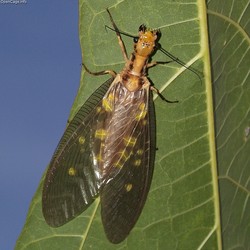
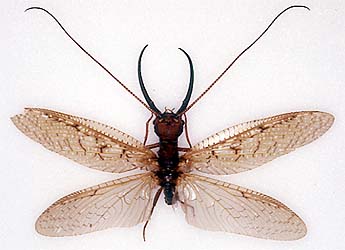

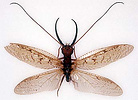

 Go to quick links
Go to quick search
Go to navigation for this section of the ToL site
Go to detailed links for the ToL site
Go to quick links
Go to quick search
Go to navigation for this section of the ToL site
Go to detailed links for the ToL site